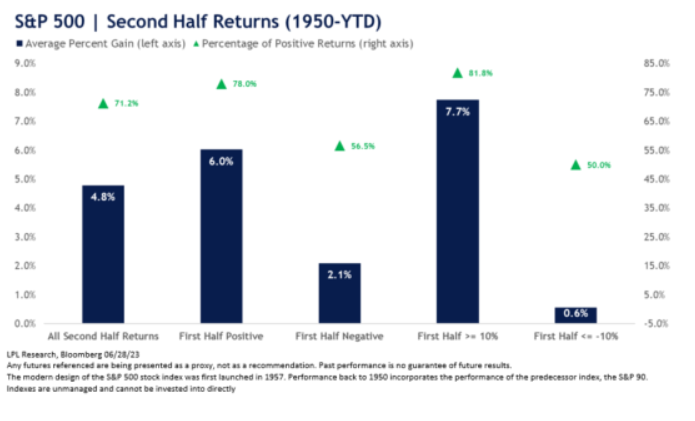You may not be aware but investing (long) in the market BEFORE a major holiday tends to have an upward bias. In fact, there are seasonal and calendar effects (as well as Presidential that we have consistently covered through the weeks and we have a strategy TOM, that takes advantage of this effect).
Therefore, it was no surprise that this past week we enjoyed an upward bias and positive returns (the best surprise was the small cap rally that continued from earlier in June).
This was certainly helped and boosted by the economic news that showed the May Core PCE (Personal Consumption Expenditure) index that came in at 4.6% versus 4.7%, the number expected by most economists. Even though that data point was a mere 0.1% less than expected, it sent the signal that the Fed Chairman and his Open Market Committee might evaluate the slowing inflation scenario as one more case for pausing or skipping more rate hikes.
Investors stepped up their buying. Or at least this is what market commentators conveyed.
My interpretation: There remains over $5 trillion in money market funds. People see the daily financial news that the markets continue higher. FOMO (fear of missing out) takes over, and they start putting money to work in the markets. Not knowing what to buy, they turn to purchasing the biggest and most well known stocks (see description of the Big 7 below).
Also, big money managers and institutions were rebalancing and executing window dressing maneuvers so that they could show their clients that they got rid of the poor performing stocks and were increasing the weightings of the best performers. Their hope is that if they are underperforming for the year, they can demonstrate to their clients that they have made recent stock and asset category decisions to put them in a more favorable position. Doesn’t always work.
The last (and perhaps most significant) factor at the end of a month/quarter is that companies are buying back their stock (reducing dilution to increase the potential ROI of the stock price) and like stealth operators in the middle of the night, they do this unnoticed.
With lighter than normal volume (people are on vacation and Wall Street managers start their weekends early), these subtle moves amplify the upward bias in the last week of June.
June was an excellent month for the Bulls.
We ended the month and the quarter on Friday with a surge higher in stock prices. This surge came after a pause in the middle of the month that gave many market technicians, (or so they thought) proof that we would start another leg down. Boy were they wrong, as the market over the last two weeks showed its strength and a broadening out.
Small caps started an impressive run earlier in June . That was evidence that small companies are shaking off higher interest rates (and threats of still higher interest rates) and seeing growth and pricing power that helps the soldiers line up with the generals.
This year, so far, has certainly been about the Mega Caps. The big 7 (Amazon (NASDAQ:AMZN), Apple (NASDAQ:AAPL), Google (NASDAQ:GOOGL), Microsoft (NASDAQ:MSFT), Netflix (NASDAQ:NFLX), Nvidia (NASDAQ:NVDA), and Tesla (NASDAQ:TSLA)) all had a good quarter and defied the pundits who say they are too big to continue growing at above average rates. Apple hit the $3 trillion mark making it the first company to do so and its brand the most valuable in the world (I confess, I am NOT an Apple user).
We wanted to provide a summary of just how “good” these markets (and their different segments) have been:

I don’t know too many investors who would have thought these numbers were possible coming out of 2022.
Let’s recap just how resilient this market has been:
June:
- S&P 500 up 6.1%, best month since January 2023
- NASDAQ Composite up 6.2% fourth consecutive positive month
- Dow Jones Industrial Average up 4.4%, best month since November, 2022
Second Quarter, 2023
- S&P 500 up 8.3%, third straight quarter of gains
- NASDAQ up 15.1%, back-to-back positive quarters
- Dow up 3.4%, third straight winning quarter.
Year-to-date (first half of 2023)
- S&P 500 up 15.9%, best first half since 2018
- NASDAQ up over 38%, best first half since 1983

Please review the chart above. You will see the obvious and significant disparity between GROWTH and VALUE on the blue and green lines (Russell 1000 Growth-Russell 1000 Value). I cannot recall this big of a difference between growth and value (over 23+%) in a long time.
The Wilshire 5000 (made up of 5,000 stocks) also exhibits more broad-based market participation than most people expect or having been talking about. See chart below:
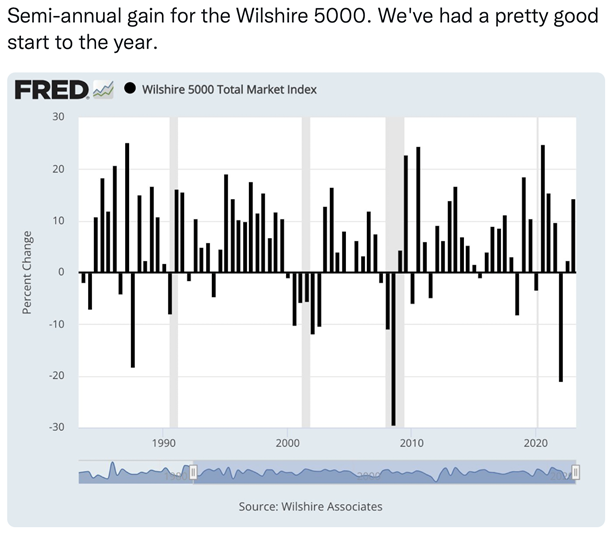
Investors entered 2023 fearful and are now experiencing greed.
We remind you that all through the past 6-12 months, we have expressed some degree of caution. Like others in our industry, we saw higher interest rates as harmful to the investment landscape. Providing a fair and balanced narrative, we have tried to provide a pro and con dialogue so that our followers remain vigilant of the perceived market risks.
While this is wise, prudent and helpful (we feel obligated to put risk first), like others, we did not foresee the rapidly changing positive sentiment readings. However, our formulaic and algo based quant models, DID CATCH these changing tides. This is both the power and strength of our investment strategies.
What is driving the positive markets and better economic news?
Surprisingly, most investment analysts came into 2023 believing we were headed for a sharp contraction in GDP and earnings growth. While we have seen an earnings slowdown (-6% expected in this quarter’s upcoming earnings), GDP has stayed strong. (This week first quarter GDP was revised upward to 2.0%) Additionally, unemployment has stayed very low and job creation has been robust. Surprisingly so.
Actually, this period (from 2020 and COVID the re-opening of the economy) has brought elevated inflation, but it has also produced one of the fastest periods of economic growth in history. See graph below:
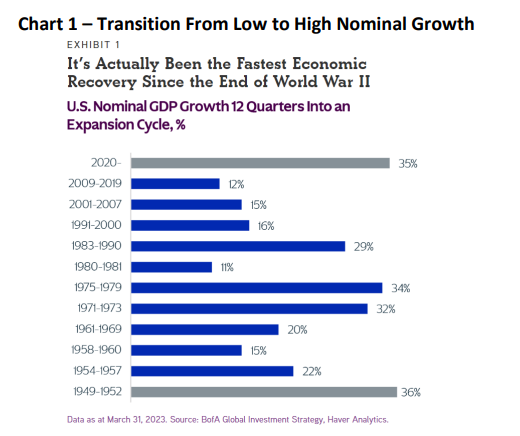
The above economic growth along with declining inflation numbers and robust consumer spending that stays strong, has resulted in the Economic Surprise Index surging (a positive )graph. See chart below:
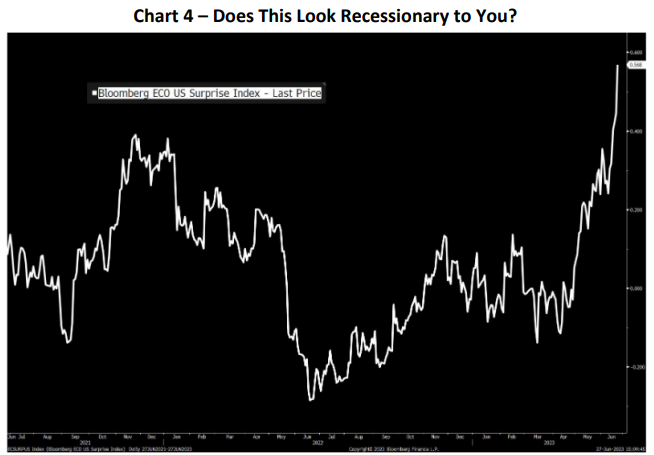
A surge in the Global PMI (Purchasing Manager Index)
Surprising and unexpected positive economic bias is also showing up around the world. Growth in GDP (Gross Domestic Product) is often preceded by the PMI. See chart below showing the recent move higher in the Global PMI. This is also why we continue to contend that the Fed will in fact, raise at least one, if not two times more in the future:
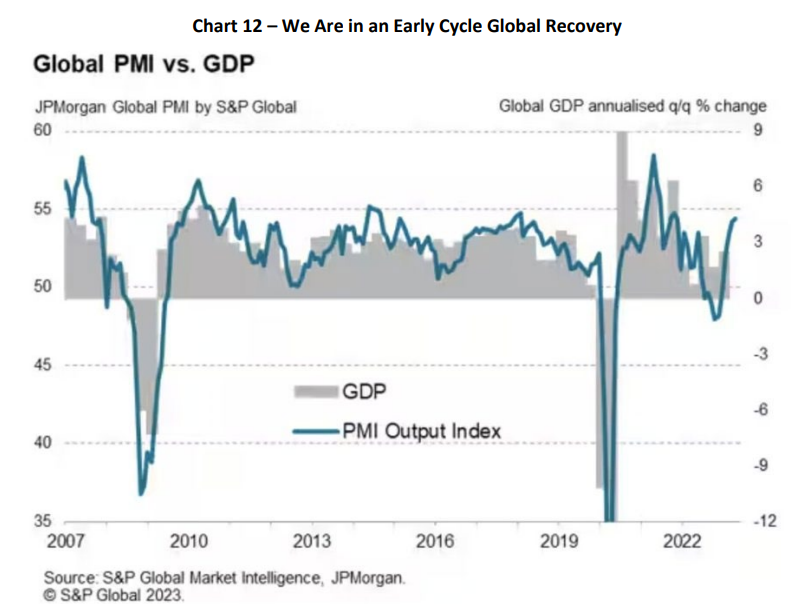
An even better indicator that people are adapting to this high inflationary period and NOT suffering through it as much as during 2022 is contained in the Misery Index (shown below). Given that unemployment is very low, most people are working (who want to), and rate of inflation is declining, the recent reading on the Misery Index provides a positive bias towards the economy.
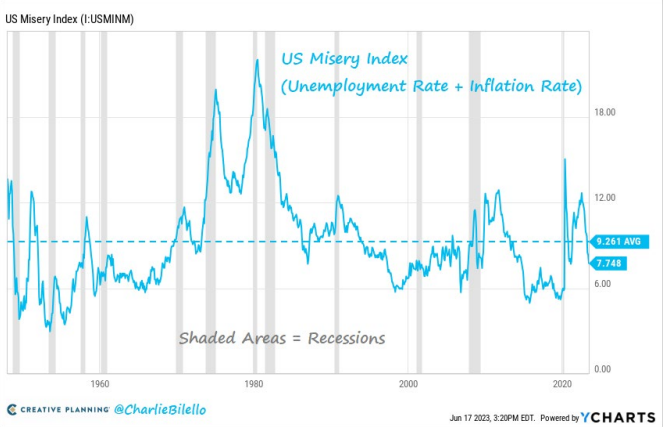
The major areas of strength (and profits) in the market exhibit just how resilient this economy is. The strongest market sectors that have also produced the best returns so far this year include Industrials, Technology (fueled by the enthusiasm of Artificial Intelligence), home construction, automobiles and travel-vacation experiences. The fact that these areas of the market are doing so well puts serious doubt that a recession is in our near future. See charts below:
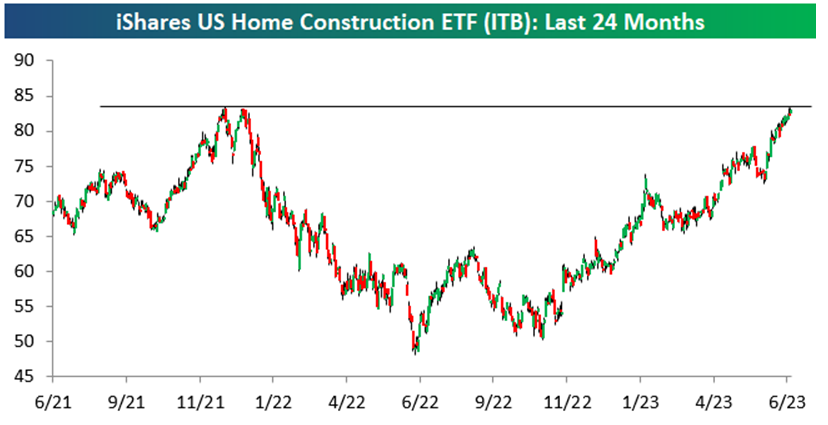
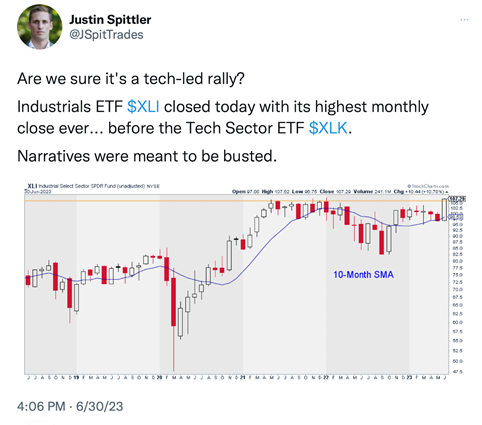
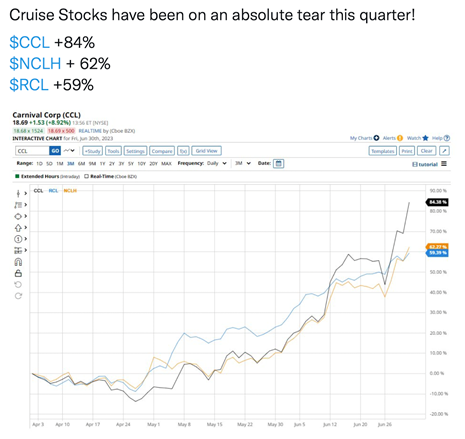
As previously mentioned, our investment models have been participating fully in these profitable areas of the market. Quite frankly, I think it has been quite a while since we have been able to take as many profit targets in one month and some of them were executed soon after investing in the new position.
Here are the 10 best stocks to have owned this year. Those that have an asterisk have either been in a MarketGauge investment portfolio or are currently in one today:
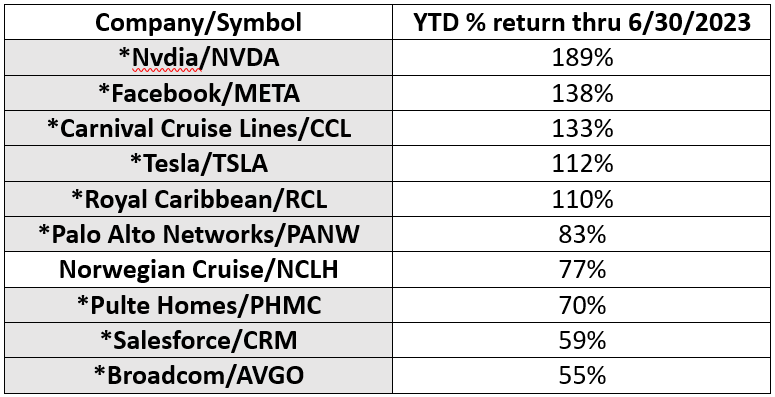
Yes, 0ur investment models have owned 9 of the 10 stocks on this list. Currently, our models are invested in 8 out of the 10 stocks listed above, some with a smaller % because we have recommended subscribers (as we have done for our investment clients) take off part of the position at a predetermined target, thereby locking in a meaningful profit.
If you are not yet a subscriber (what’s stopping you?) and don’t have access to the strategies please contact Rob Quinn at Rob@MarketGauge.com or me at Donn@MGAMLLC.com and we will send you a factsheet on how these strategies did for the quarter. We are both available to help you make heads or tails on how to blend these strategies together as well. (Most of them are well ahead of the indices this year so far).
What’s Next?
No recession? Bank of America (NYSE:BAC) believes that inflation could be headed for a big drop and prices cool without having to endure a recession. Strategists continue to point to the inverted 2- and 10-year Treasury yield curve, the bond market’s notorious recession gauge. This “gauge” has successfully predicted numerous downturns, most recently in 1990, 2001 and 2008. B of A, however, thinks the indicator is predicting a hard landing for inflation, not the economy. They believe we will avoid a recession.
Yet, the NY Fed puts the probability of a recession in the next 12 months at over 50%. See chart below.
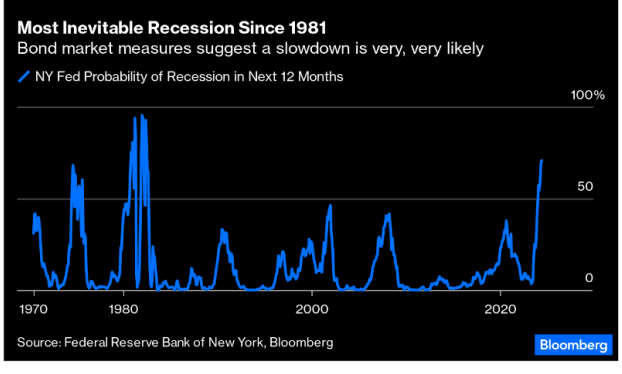
Morgan Stanley (NYSE:MS) agrees with this prognostication. Lisa Shalett, chief investment officer for Morgan Stanley Wealth Management (whom I have worked with in the past), sees a “huge hurdle: ahead for commercial real estate and particularly office properties that have seen rising vacancy rates and falling property values since the pandemic.
“More than 50% of the $2.9 trillion in commercial mortgages will need to be renegotiated in the next 24 months when new lending rates are likely to be up by 350-450 basis points”, Shalett wrote. For those reasons, Shalett and the bank’s analysts “forecast a peak-to-trough CRE price decline of as much as 40% worse than in the Great Financial Crisis”.
Ms. Shalett has certainly had an effect on Mike Wilson, the Chief Market Strategist and overriding market voice of Morgan Stanley. Mr. Wilson believes we may still see the S&P trade down near the October lows and has an end of year forecast of 4000-4200 on the S&P 500.
While the Home Construction sector has been good for investing (see above). There has been a significant shortage of available homes in major markets. Given that many people took out low mortgages during the Pandemic (or refinanced), older homes are not turning over as people stay in their properties. So homebuilders are scrambling to build new homes in new developments. Looking at the charts, It even looks to us that Homebuilders may be breaking out of old resistance and may continue to move higher.
However, we thought we might share a chart from our partners at Decision Point (great research service) that demonstrates the current difficult environment for homeowners who require a mortgage to complete their purchase. My take is many of them are taking out Adjustable Rate Mortgages (ARMS) in anticipation that the economy will slow and rates will come down in the future and allow them to refinance.
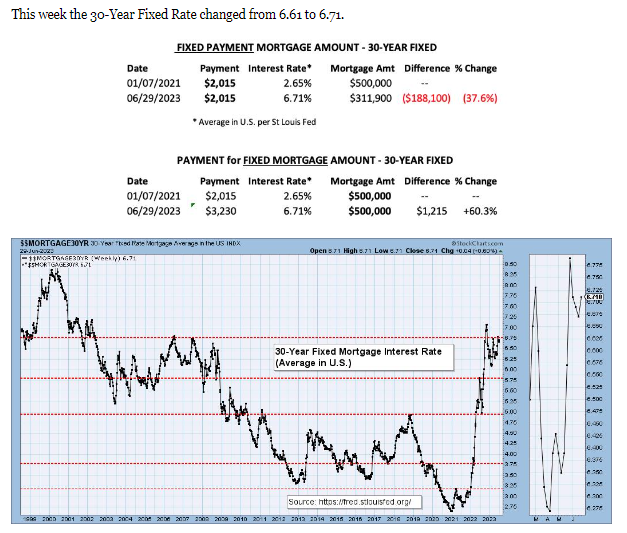
Where are the hot markets for younger homebuyers that are buying these home? See chart below.

What’s in store for the market for the remainder of 2023?
Truthfully, at this point, with all of the economic data contradictions, neither us nor many analysts know for certain what will occur in the markets for the remainder of the year. We are entering what is typically an unfavorable period (3rd quarter) and one that may be marked by a surprise in earnings, potentially to the downside.
We have written extensively in previous Market Outlooks about what happens if the market is up over 10% for the first six months. This is a FAVORABLE statistic, and you can review the chart we posted in last week’s Market Outlook.
Here is another chart that further points out the positive bias the markets should have given the first half’s stellar performance.
